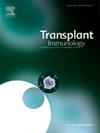Outcomes of CMV infection in the setting of gastrointestinal graft-vs.-host disease in the era of pre-emptive and prophylactic antiviral therapy
IF 1.4
4区 医学
Q4 IMMUNOLOGY
引用次数: 0
Abstract
Background
Concurrent cytomegalovirus infection (CMVi) and gastrointestinal graft-versus-host disease (GI-GVHD) poses significant risks for increased morbidity and mortality in patients undergoing allogeneic hematopoietic cell transplantation (allo-HCT). Primary prophylaxis with letermovir therapy has been shown to decrease the risk of CMV reactivation, but studies examining this relationship after GI-GVHD are lacking. We reviewed our center's outcomes associated with concomitant CMVi and GI-GVHD before and after our adopting the use of letermovir therapy for CMV prophylaxis in 2017.
Methods
This was a single-center, retrospective study of allo-HCT patients who developed GI-GVHD and CMVi between June 2013 and June 2021. CMVi was defined as detection of CMV in the blood or detection of CMV in sampled tissue. CMV colitis was defined as biopsy-proven tissue-invasive CMV disease. The primary outcome was one year survival.
Results
We evaluated 43 allo-HCT patients who had concomitant CMVi and GI-GVHD. Out of 43 patients, 40 of them (93 %) had a high risk serostatus for CMVi (recipient seropositive). CMV colitis was confirmed by biopsy in 18 patients (42 %) and was clinically suspected in 20 patients (47 %). Twenty-five patients (58 %) developed CMV viremia, and 18 of them developed concomitant biopsy proven CMV colitis. Nine patients (21 %) received letermovir therapy for primary CMV prophylaxis, and 7 of these 9 patients (78 %) developed breakthrough CMVi while receiving prophylaxis. The median time from HCT to CMVi was similar between the group that received letermovir prophylaxis and the group that did not. Median peak CMV levels were lower in the prophylaxis group. Overall survival rates at one and five years were 65 % and 21 %, respectively, with the mortality reaching 25 % at 164 days and 50 % at 480 days. There was no statistically significant difference in one year survival between patients with CMV viremia but without colitis compared to those with CMV viremia and colitis (p = 0.648, 95 % CI 0.3–1.57). One-year survival was also not statistically different between patients who received letermovir prophylaxis compared to those who did not (p = 0.250, 95 % CI 0.60–6.97) or between patients with high grade GI-GVHD (grade 3–4) and low-grade GI-GVHD (grade 1–2; p = 0.277, 95 % CI 0.64–4.83).
Conclusion
In this high-risk cohort with GI-GVHD and CMVi, the peak viral load was lower in the group that received letermovir prophylaxis, but the median time to onset of CMVi and survival were not statistically different. The majority of patients in the letermovir prophylaxis group developed CMVi while on letermovir. Further investigations with larger sample sizes may better assess the impact of letermovir therapy on patient survival and the development of CMVi outcomes in the setting of GI-GVHD in the era of pre-emptive prophylactic antiviral therapy.
胃肠道移植物对巨细胞病毒感染的影响。-宿主病时代的预防性抗病毒治疗
背景巨细胞病毒感染(CMVi)和胃肠道移植物抗宿主病(GI-GVHD)并发对接受同种异体造血细胞移植(alloo - hct)的患者的发病率和死亡率增加具有显著的风险。莱替莫韦治疗的初级预防已被证明可以降低巨细胞病毒再激活的风险,但缺乏对GI-GVHD后这种关系的研究。我们回顾了本中心在2017年采用莱替莫韦治疗CMV预防前后与CMVi和GI-GVHD相关的结果。方法:这是一项单中心、回顾性研究,研究对象是2013年6月至2021年6月期间发生GI-GVHD和CMVi的同种异体hct患者。CMVi定义为血液中CMV的检测或样本组织中CMV的检测。巨细胞病毒结肠炎被定义为活检证实的组织侵袭性巨细胞病毒疾病。主要终点为1年生存率。结果我们评估了43例伴有CMVi和GI-GVHD的allo-HCT患者。在43例患者中,其中40例(93%)具有CMVi高危血清状态(受体血清阳性)。18例(42%)患者活检证实巨细胞病毒结肠炎,20例(47%)患者临床怀疑巨细胞病毒结肠炎。25例(58%)患者发生巨细胞病毒血症,其中18例并发活检证实巨细胞病毒结肠炎。9名患者(21%)接受莱特莫韦治疗进行原发性巨细胞病毒预防,其中7名患者(78%)在接受预防治疗时出现突破性巨细胞病毒。从HCT到CMVi的中位时间在接受雷特莫韦预防组和未接受雷特莫韦预防组之间相似。预防组CMV的中位峰值水平较低。1年和5年的总生存率分别为65%和21%,164天和480天的死亡率分别为25%和50%。巨细胞病毒血症合并结肠炎患者与巨细胞病毒血症合并结肠炎患者的1年生存率差异无统计学意义(p = 0.648, 95% CI 0.3-1.57)。接受雷替莫韦预防的患者与未接受雷替莫预防的患者的一年生存率也无统计学差异(p = 0.250, 95% CI 0.60-6.97),高级别GI-GVHD患者(3-4级)与低级别GI-GVHD患者(1-2级;p = 0.277, 95% CI 0.64-4.83)。结论在伴有GI-GVHD和CMVi的高危队列中,接受莱替韦预防组的病毒峰值载量较低,但CMVi发病的中位时间和生存期无统计学差异。雷替莫韦预防组的大多数患者在使用雷替莫韦时发生了CMVi。在预防性抗病毒治疗时代,更大样本量的进一步研究可能更好地评估莱替莫韦治疗对GI-GVHD患者生存和CMVi结局发展的影响。
本文章由计算机程序翻译,如有差异,请以英文原文为准。
求助全文
约1分钟内获得全文
求助全文
来源期刊

Transplant immunology
医学-免疫学
CiteScore
2.10
自引率
13.30%
发文量
198
审稿时长
48 days
期刊介绍:
Transplant Immunology will publish up-to-date information on all aspects of the broad field it encompasses. The journal will be directed at (basic) scientists, tissue typers, transplant physicians and surgeons, and research and data on all immunological aspects of organ-, tissue- and (haematopoietic) stem cell transplantation are of potential interest to the readers of Transplant Immunology. Original papers, Review articles and Hypotheses will be considered for publication and submitted manuscripts will be rapidly peer-reviewed and published. They will be judged on the basis of scientific merit, originality, timeliness and quality.
 求助内容:
求助内容: 应助结果提醒方式:
应助结果提醒方式:


